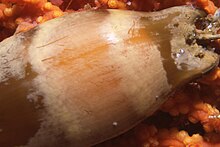Haploblepharus
| Haploblepharus | |
|---|---|

| |
| Puffadder shyshark (H. edwardsii) | |
| Scientific classification | |
| Domain: | Eukaryota |
| Kingdom: | Animalia |
| Phylum: | Chordata |
| Class: | Chondrichthyes |
| Subclass: | Elasmobranchii |
| Subdivision: | Selachimorpha |
| Order: | Carcharhiniformes |
| Family: | Scyliorhinidae |
| Genus: | Haploblepharus Garman, 1913 |
| Type species | |
| Squalus edwardsii Schinz 1822
| |
Haploblepharus is a
Taxonomy and phylogeny
The genus Haploblepharus was created by American zoologist Samuel Garman in 1913, in the 36th volume of Memoirs of the Museum of Comparative Zoology, at Harvard College, to contain the puffadder shyshark, then known as Squalus edwardsii.[1] The name is derived from the Greek haplóos meaning "single", and blepharos meaning "eyelid".[2]
In 1988,
Species
- Haploblepharus edwardsii (Schinz, 1822) (puffadder shyshark)
- J. L. B. Smith, 1950 (brown shyshark)
- Compagno, 2006 (Natal shyshark)
- Haploblepharus pictus (J. P. Müller & Henle, 1838) (dark shyshark)
Distribution and habitat
All four shyshark species are
Description

Different shyshark species are very similar to one another in appearance but can be reliably differentiated using morphological measurements. However, in the field the only way to readily tell them apart is by their different color patterns, and even this may be problematic as individuals of the same species can vary considerably in coloration.[4] All four species are small, seldom exceeding 60 cm (24 in) in length.[5]
A shyshark has a stout, spindle-shaped body and a short head comprising less than one-fifth of the total length. The head is broad and dorsally flattened, with a rounded snout. The large, oval eyes have cat-like slit pupils, a rudimentary nictitating membrane (protective third eyelid), and a prominent ridge running underneath. A distinguishing trait of this genus are the large nostrils partially covered by greatly expanded, triangular flaps of skin that overlap the mouth and cover a pair of deep grooves between the nasal excurrent (outflow) openings and the mouth. The mouth is short and curved, with furrows at the corners extending onto both jaws. The teeth have a central cusp and smaller lateral cusplets. The five pairs of gill slits are located on the upper side of the body.[1]
The two
Biology and ecology

Shysharks feed on a variety of small benthic
Human interactions
Due to their small size, shysharks pose no danger to humans and are not sought by either
References
- ^ ISBN 92-5-101384-5.
- ^ Bester, C. Biological Profiles: Puffadder Shyshark. Florida Museum of Natural History Ichthyology Department. Retrieved on August 31, 2009.
- PMID 16293425.
- ^ Human, B.A. (2007). "Size-corrected shape variation analysis and quantitative species discrimination in a morphologically conservative catshark genus, Haploblepharus Garman, 1913 (Chondrichthyes: Carcharhiniformes: Scyliorhinidae)". African Natural History. 3: 59–73.
- ISBN 1-86872-890-0.
- ^ Dainty, A.M. (2002). Biology and ecology of four catshark species in the southwestern Cape, South Africa. M.Sc. thesis, University of Cape Town.
- ISBN 2-8317-0700-5.
